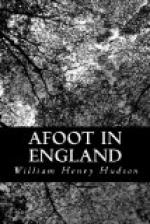Troubled at his failure, he went back and questioned his landlord, and, naturally, was asked for the name of the farm he was seeking. He had forgotten the name—he even doubted that he had ever heard it. But there was his family name to go by—Dyson; did any one remember a farmer Dyson in the village? He was told that it was not an uncommon name in that part of the country. There were no Dysons now in Thorpe, but some fifteen or twenty years ago one of that name had been the tenant of Long Meadow Farm in the parish. The name of the farm was unfamiliar, and when he visited the place he found it was not the one he sought.
It was a grievous disappointment. A new sense of loneliness oppressed him; for that bright image in his mind, with the feeling about his home, had been a secret source of comfort and happiness, and was like a companion, a dear human friend, and now he appeared to be on the point of losing it. Could it be that all that mental picture, with the details that seemed so true to life, was purely imaginary? He could not believe it; the old house had probably been pulled down, the big trees felled, orchard and hedges grabbed up—all the old features obliterated—and the land thrown into some larger neighbouring farm. It was dreadful to think that such devastating changes had been made, but it had certainly existed as he saw it in his mind, and he would inquire of some of the old men in the place, who would perhaps be able to tell him where his home had stood thirty years ago.
At once he set about interviewing all the old men he came upon in his rounds, describing to them the farm tenanted by a man named Dyson about forty years ago, and by and by he got hold of one who knew. He listened for a few minutes to the oft-repeated story, then exclaimed, “Why, sir, ’tis surely Woodyates you be talking about!”
“That’s the name! That’s the name,” he cried. “Woodyyates-how did I ever forget it! You knew it then—where was it?”
“I’ll just show you,” said the old man, proud at having guessed rightly, and turning started slowly hobbling along till he got to the end of the lane.
There was an opening there and a view of the valley with trees, blue in the distance, at the furthest visible point. “Do you see them trees?” he said. “That’s where Harping is; ’tis two miles or, perhaps, a little more from Thorpe. There’s a church tower among them trees, but you can’t see it because ’tis hid. You go by the road till you comes to the church, then you go on by the water, maybe a quarter of a mile, and you comes to Woodyates. You won’t see no difference in it; I’ve knowed it since I were a boy, but ’tis in Harping parish, not in Thorpe.”
Now he remembered the name—Harping, near Thorpe—only Thorpe was the more important village where the inn was and the shops.
In less than an hour after leaving his informant he was at Woodyates, feasting his eyes on the old house of his dreams and of his exiled father’s before him, inexpressibly glad to recognize it as the very house he had loved so long—that he had been deceived by no false image.




